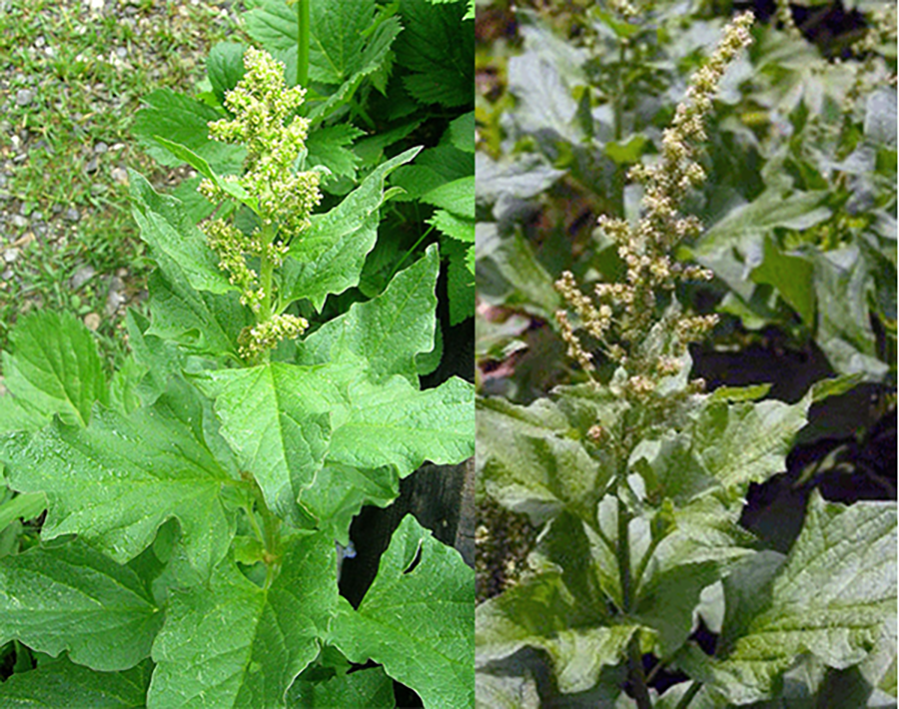 Good King Henry
Chenopodium
bonus-henricus,
whole plant..
Good King Henry
Chenopodium
bonus-henricus,
whole plant..
Welcome to the summary page for FabulousFusionFood's Herb guide to Good King Henry along with all the Good King Henry containing recipes presented on this site, with 5 recipes in total.
e This is a continuation of an entire series of pages that will, I hope, allow my visitors to better navigate this site. As well as displaying recipes by name, country and region of origin I am now planning a whole series of pages where recipes can be located by meal type and main ingredient. This page gives a listing of all the Cornish recipes added to this site.
These recipes, all contain Good King Henry as a major herb flavouring.
Good King Henry, Chenopodium bonus-henricus (also known as Poor-man's Asparagus and Lincolnshire Spinach) is a perennial plant and a member of the Amaranthaceae (amaranth) family which grows to some 80cm high. The plant's stem bears leaves that are some 5–10cm long (and broad) and which are spear-shaped and have a pair of broad pointed lobes near the base. The texture of the leaves is somewhat waxy and reflective. The plant is a native of the Mediterranean but seems to have been transplanted to northern Europe with the migration of some of the earliest farmers some 5000 years ago. The plants grow well in well-manured ground and were thus seen near early farmsteads where they were cultivated. They continued as a popular cottage pot-herb through the Medieval era, until broad-leaved spinaches became broadly available. As a perennial Good King Henry can be treated as an everlasting spinach as long as only a few leaves are harvested from a single plant at any one time.
Though this plant can be picked in the wild, it is now being offered as a potherb by specialist herb nurseries and is well worth growing it in your own herb garden. The leaves of the plant can be cooked simply as a spinach and the stems make a rather inferior substitute to asparagus if the young shoots are cut when they are no more than 20cm high with the leaves being stripped off. This should be tied in bundles and boiled for no more than eight minutes.
Interestingly, rather than being a reference to any of the Henrician kings of England, the plant's name refers to 'Good Henry' an elf-like figure from Saxon folklore. In recent years Good King Henry has returned to popularity as a herb garden perennial and commercial seed for this plant are now fairly readily available.
e This is a continuation of an entire series of pages that will, I hope, allow my visitors to better navigate this site. As well as displaying recipes by name, country and region of origin I am now planning a whole series of pages where recipes can be located by meal type and main ingredient. This page gives a listing of all the Cornish recipes added to this site.
These recipes, all contain Good King Henry as a major herb flavouring.
Good King Henry, Chenopodium bonus-henricus (also known as Poor-man's Asparagus and Lincolnshire Spinach) is a perennial plant and a member of the Amaranthaceae (amaranth) family which grows to some 80cm high. The plant's stem bears leaves that are some 5–10cm long (and broad) and which are spear-shaped and have a pair of broad pointed lobes near the base. The texture of the leaves is somewhat waxy and reflective. The plant is a native of the Mediterranean but seems to have been transplanted to northern Europe with the migration of some of the earliest farmers some 5000 years ago. The plants grow well in well-manured ground and were thus seen near early farmsteads where they were cultivated. They continued as a popular cottage pot-herb through the Medieval era, until broad-leaved spinaches became broadly available. As a perennial Good King Henry can be treated as an everlasting spinach as long as only a few leaves are harvested from a single plant at any one time.
Though this plant can be picked in the wild, it is now being offered as a potherb by specialist herb nurseries and is well worth growing it in your own herb garden. The leaves of the plant can be cooked simply as a spinach and the stems make a rather inferior substitute to asparagus if the young shoots are cut when they are no more than 20cm high with the leaves being stripped off. This should be tied in bundles and boiled for no more than eight minutes.
Interestingly, rather than being a reference to any of the Henrician kings of England, the plant's name refers to 'Good Henry' an elf-like figure from Saxon folklore. In recent years Good King Henry has returned to popularity as a herb garden perennial and commercial seed for this plant are now fairly readily available.
The alphabetical list of all Good King Henry recipes on this site follows, (limited to 100 recipes per page). There are 5 recipes in total:
Page 1 of 1
| A Messe of Greens Origin: Britain | Potato and Good King Henry Frittata Origin: Britain | Wild Herb Casserole Origin: Britain |
| Good King Henry Aloo Origin: Fusion | Wild Greens Soup Origin: Britain |
Page 1 of 1